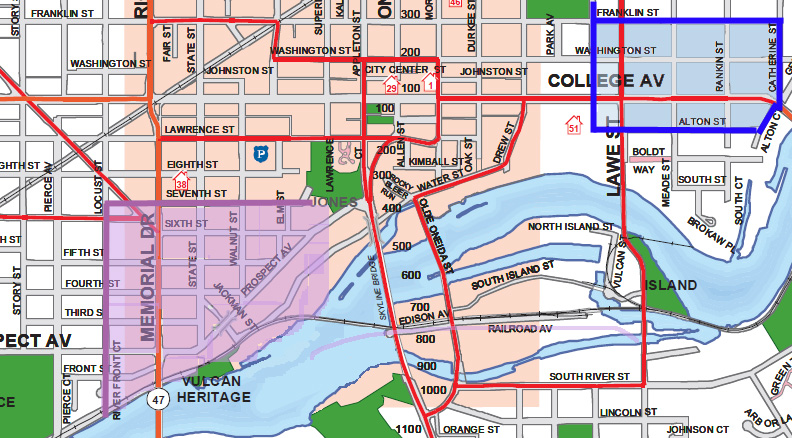Brown county, Michigan Territory, was given the following boundaries: "Bounded on the north by the county of Michilimackinac as established by an act of the governor of the said territory of this date; on the east by the said county of Michilimackinac and by the western boundary of the said territory as the same was established by the Act of Congress passed January 11, 1805, entitled 'An Act to divide the Indiana Territory into two separate governments;' on the south by the states of Indiana and Illinois; and on the west by a line to be drawn due north from the northern boundary of the State of Illinois through the middle of the portage between the Fox river and the Ouissin (Wisconsin) river to the county of Michilimackinac, into a separate county to be called the county of Brown, October 26, 1818."
-- Thomas Henry Ryans' History of Outagamie County, Part 2.
Before there were any permanent settlers, before the land was surveyed, before the natives ceded most of their land, the Old Third Ward was part of Brown County with the borders shifting slightly over the subsequent years. When Wisconsin became the 30th state in 1848 and when the township of Grand Chute was established, the following year this area was still Brown County.
 The Old Third Ward may well have been located in the city of Martin. The western section of Jean Baptiste Benoit's land was purchased by
Morgan L. Martin, Theodore Conkey, and Abraham B. Bowen just east of the present Pierce Park. This village was given the name of Martin. Three villages were located along the Fox River: Lawesburg, laid out by George W. Lawe, the easternmost, bordered by Union Street on the west, Franklin Street on the north, Catherine Street and Alton Court on the east, and on the south John and Alton Streets. Martin was "separated by deep ravines as well as a dense forest, was commenced at the point opposite the magnificent water-fall" (according to The History of Outagamie County,) southwest of the village of Appleton bordered by the Fox River, Locust and Seventh Streets. The village of Appleton, named for Sarah Appleton, wife of Amos Lawrence, lay in the center. The contemporary map illustrates these divisions: Martin (this name was used as late as 1850 but was then changed to Grand Chute) in purple, Lawesburg in blue. When the three villages were incorporated into the village of Appleton in 1853, these three sections roughly became the first three wards of the new village.
The Old Third Ward may well have been located in the city of Martin. The western section of Jean Baptiste Benoit's land was purchased by
Morgan L. Martin, Theodore Conkey, and Abraham B. Bowen just east of the present Pierce Park. This village was given the name of Martin. Three villages were located along the Fox River: Lawesburg, laid out by George W. Lawe, the easternmost, bordered by Union Street on the west, Franklin Street on the north, Catherine Street and Alton Court on the east, and on the south John and Alton Streets. Martin was "separated by deep ravines as well as a dense forest, was commenced at the point opposite the magnificent water-fall" (according to The History of Outagamie County,) southwest of the village of Appleton bordered by the Fox River, Locust and Seventh Streets. The village of Appleton, named for Sarah Appleton, wife of Amos Lawrence, lay in the center. The contemporary map illustrates these divisions: Martin (this name was used as late as 1850 but was then changed to Grand Chute) in purple, Lawesburg in blue. When the three villages were incorporated into the village of Appleton in 1853, these three sections roughly became the first three wards of the new village.
Most of the 619 inhabitants in 1850 lived in not in Martin but in the other two villages. It would be safe to say the majority or residents in the western outlying area were farmers.
It wasn't until 1851 that State Senator Theodore Conkey proposed dividing Brown County and creating a separate county: "By Mr. Conkey, No. 17, Senate. A bill to divide the county of Brown and to create the county of Utaghamie, Wednesday, January 15, 1851." The name "Utaghamie" was changed to "Fox," then "Outagamie." Finally on February 17, 1851 "Outagamie" county was created. The Town of Grand Chute was chosen as the county seat. In August of 1851 Conkey deeded a square block in Grand Chute, originally belonging to early settler Jean Baptiste Benoit, to the newly formed county:
"Whereas, Theodore Conkey is desirous of deeding to this county Block No. 31 in the town of Grand Chute and to erect county buildings on said block as this board shall direct; therefore"Resolved, That Block No. 31 or a part of said block and other lands adjoining it on the east in the plat of the village of Appleton shall be the block on which to erect the county buildings, which shall be accepted for county purposes, provided said Conkey erect the county buildings as the county supervisors shall direct otherwise not."
This block would become the Outagamie County grounds between Sixth, Seventh, Walnut and County streets. The first county courthouse would be erected in 1855. The city of Appleton would be incorporated two years later.
In just over twenty years since Hippolyte Grigon built "White Heron" and his family became the first permanent settlers in what would become Appleton, a state, county and city had been formed. A university was thriving, residents were pouring in, and the Fox River was starting to become the life line of the community.
Back to: Old Third Ward History
Sources consulted:
Appleton Public Library. Appleton History - Outagamie County.
Raney, William Francis. "Appleton." Wisconsin Magazine of History. Vol. 33, No. 2 (1949-1950)
Ryan, Thomas Henry. History of Outagamie County..., Parts 1 and 2. Chicago: Goodspeed Historical Association
Publishers, [1911?]. http://www.foxvalleymemory.org/Ryans/indextext.html
